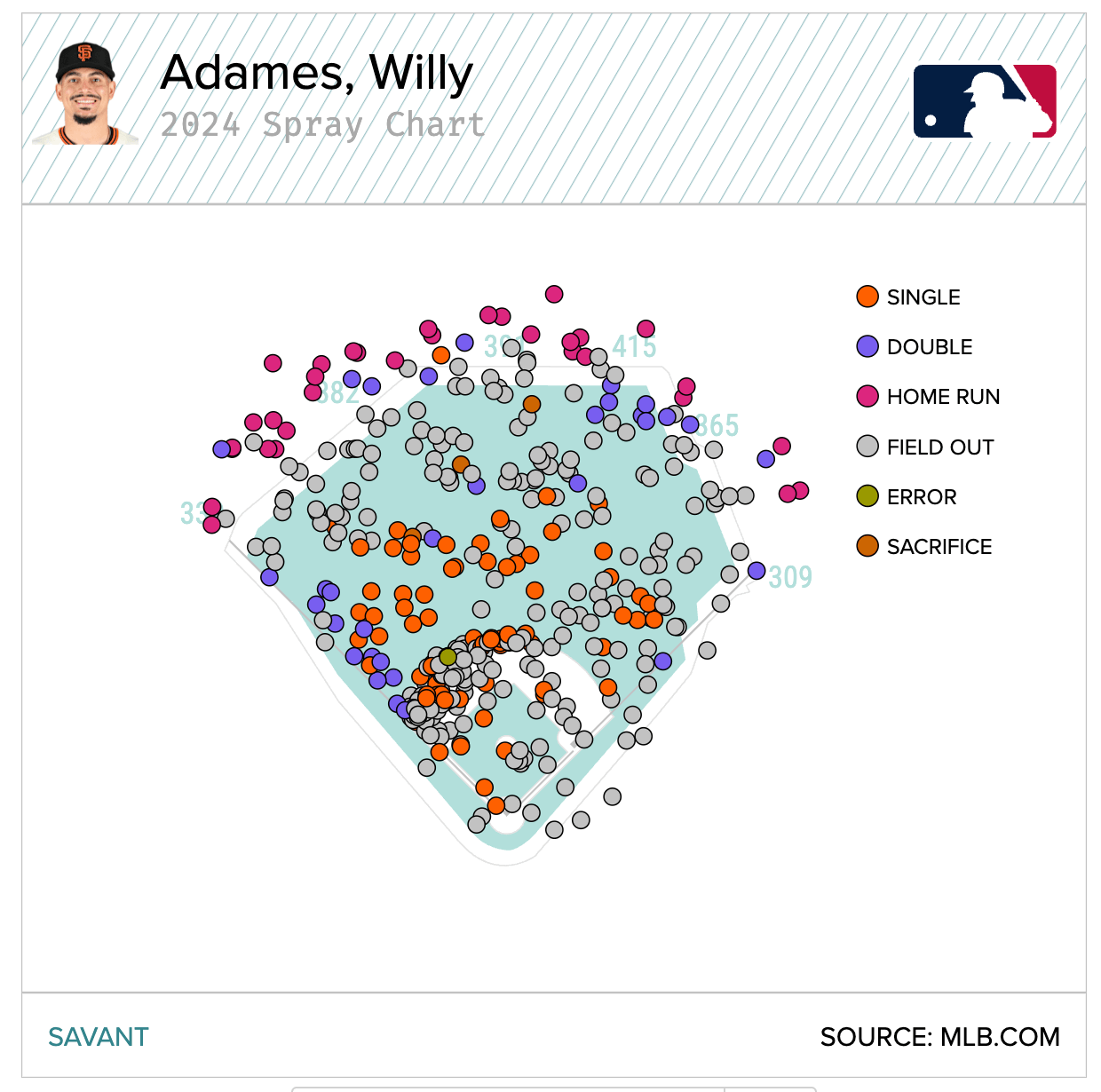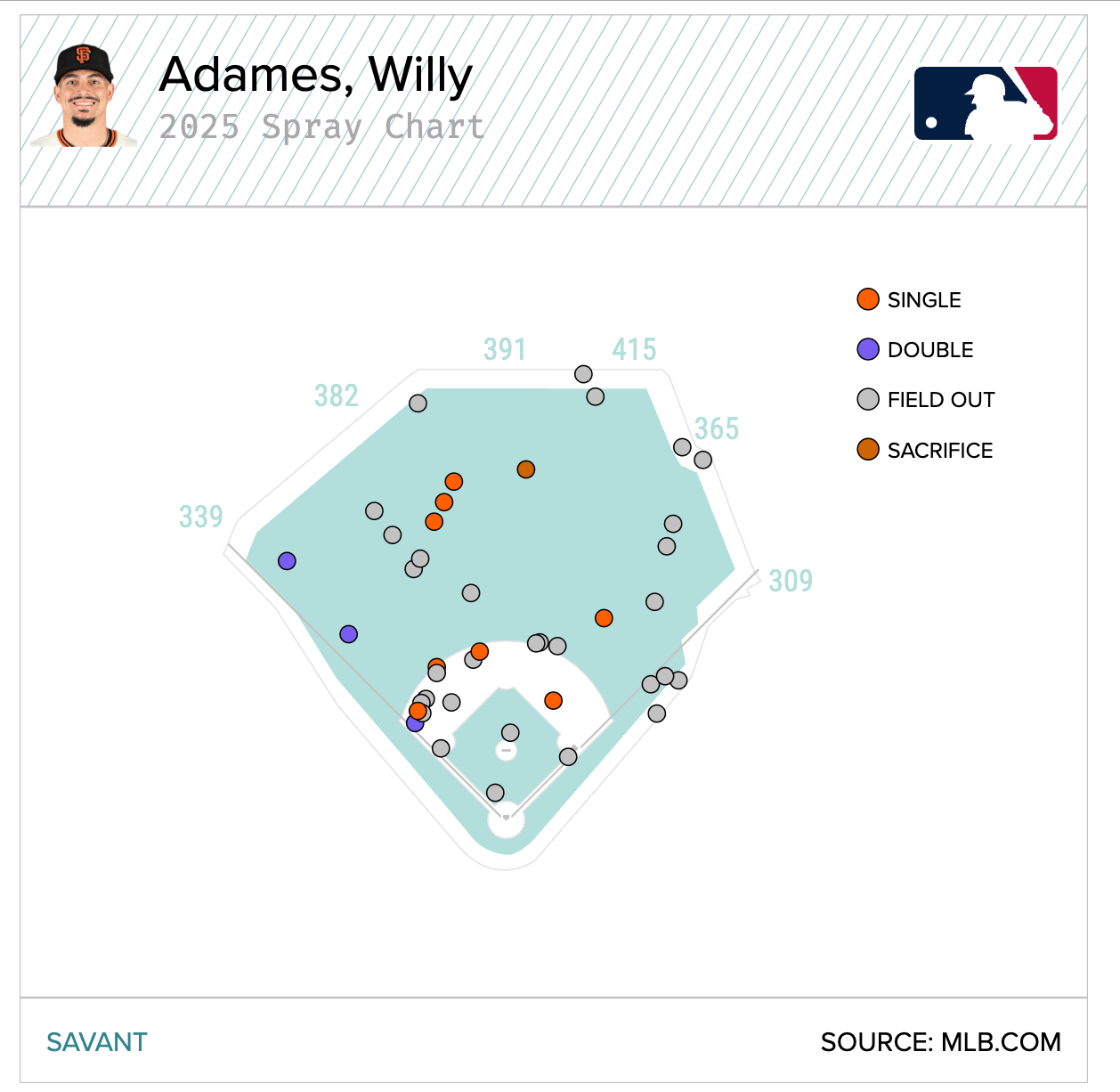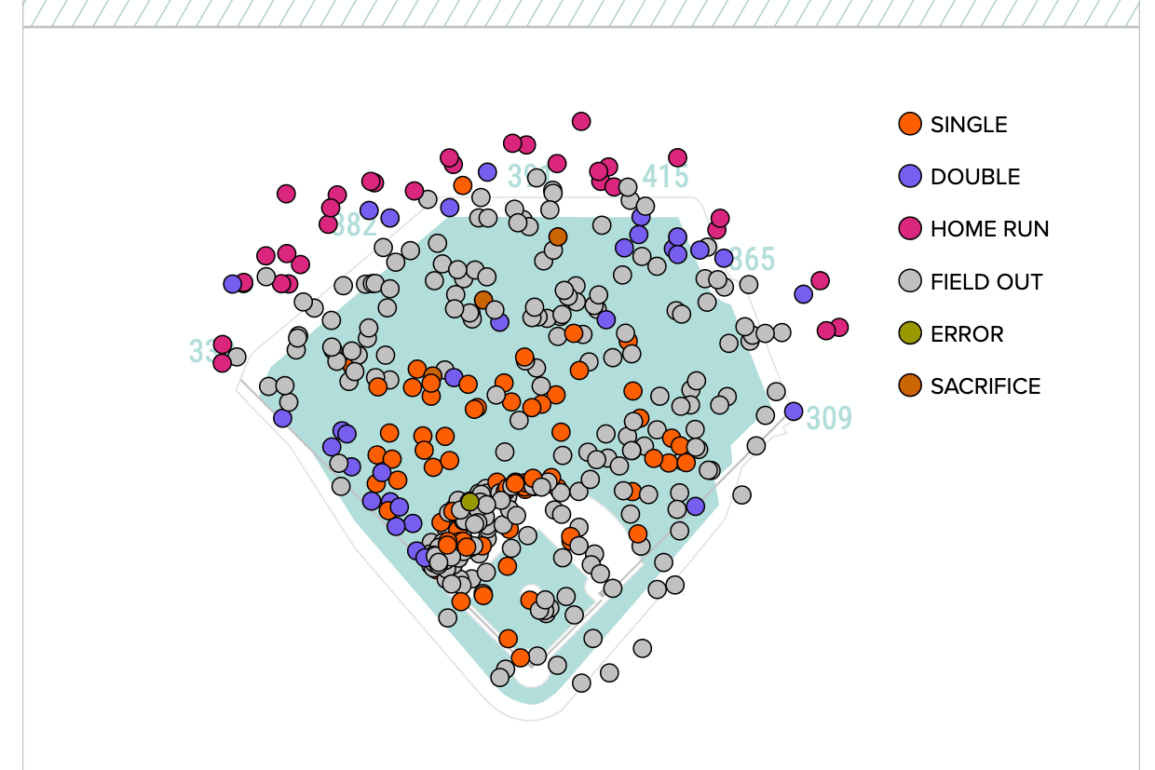On Monday morning, Tyler Fitzgerald had a .237/.293/.289 slash line. His OPS was .582, just nine points above Johnnie LeMaster’s career OPS with the Giants. If you like your statistics to be fancier, Fitzgerald’s wRC+ was 72, which would have been the second-worst in baseball last season.
After Monday evening, Fitzgerald was hitting .286/.333/.476. His OPS jumped to .809, more than 10 points higher than the career marks of Craig Biggio and Ryne Sandberg, both Hall of Famers. His wRC+ was 131, which would have been the 23rd-best in baseball last season.
Advertisement
Early-season statistics can be deceptive. You already knew that, but Fitzgerald’s instant turnaround is as good a reminder as you’ll ever get. In one night, he went from LeMaster to Hall of Famer. He started the day with the kind of stat line that would make it hard for a free agent to get a minor-league contract, and he ended it with the kind of stat line that would get votes at the bottom of MVP ballots. It was a great night, to be sure — he was just a single short of the cycle, and he both scored and drove in three runs — but one great night shouldn’t make that much of a difference. Once you get a couple more weeks of games in, it won’t.
Right now, though, it’s a bit muddled. The Giants are 12-4 and one of the talks of the early season, but that doesn’t mean every player on the team is swinging the bat well right now. So let’s examine the players who are scuffling and see if there’s any signal buried in the noise of their early-season stats. Let’s see if there’s any indication that they might pull a Fitzgerald and get their numbers up in a hurry. It’s possible that, as good as the Giants’ offense has been overall this season (fourth in runs scored), there are still places where they can expect improvement.
Willy Adames
Reason for optimism: His opposite-field home run on Monday night
Adames is a pull hitter, but he definitely has power to all fields. Here’s his spray chart from the 2024 season, via Baseball Savant:

An enduring Krukow-ism is “when he’s going right, he’ll use the whole field,” and it applies to Adames. It mostly applies to his power, though. He’s not going to hit .300 because of opposite-field singles, Opening Day notwithstanding, but he got to 30 home runs with a spray chart like the one above. His 2025 spray chart wasn’t nearly as fun heading into Monday’s game.

It looks a little better after this swing:
There’s a lot of blue ink on his Baseball Savant page, which is the bad kind, but there’s a lot of sample-size chicanery going on there, too. With a couple more swings like that, he should be the contributor the Giants have been waiting for.
Patrick Bailey
Reason for optimism: He’s actually been hitting the ball harder than anyone else on the team.
Advertisement
Average exit velocity is subject to the same early-season noise as a lot of the other statistics, so in the same way that Fitzgerald can go from a .500-something OPS to an .800-something OPS in one night, it won’t take that many hard-hit balls to get an average exit velocity up right now.
Still, Bailey has hit 12 balls harder than 95 mph, which is what MLB uses as a cutoff to define a hard hit. That gives him more hard hits per ball put in play than anyone else on the team, including Jung Hoo Lee. The problem is that there haven’t been nearly enough balls in play. Bailey’s 31.1 percent strikeout percentage is one of the worst in the league.
It’s also not typical for him. Bailey struck out 22.3 percent of the time last year, which was just a little better than the league average, and that’s even including his historically miserable August. He doesn’t have an extreme amount of swing-and-miss in his game, and he’s never been a hitter who chases often. He’ll struggle, but it’s rarely because he’s swinging at everything, and that’s another point in his favor so far: Even with the high strikeout rate, his chase rate is roughly the same as it was last season, when it was comfortably above-average.
Even if you ignore that Bailey is still just 25 and very much a young, developing hitter, he probably hasn’t transformed into one of the game’s biggest whiffers overnight. Everything else looks the same, and it probably is. That’s not someone who should hit in the middle of the order, but it’s also someone who can help more than he has so far.
LaMonte Wade, Jr.
Reason for optimism: The chase rate is still elite, and he’s still hitting the ball hard.
Like Bailey, Wade’s strikeout rate is through the roof compared to last season — 32 percent, compared to 22.4 percent in 2024. Unlike Bailey, though, Wade’s walk rate has plummeted as the strikeout rate has risen. He’s also swinging at more pitches outside of the strike zone, reverting to his 2022 rate, which was worse than the major league average.
Advertisement
If that sounds bad, that’s because it’s been bad. Wade is hitting .109, and all of his hits this season, except one, were stuffed into the same two games. He’s had a three-hit game, a pair of one-hit games and 15 different hitless games. But while it’s lazy to blame everything on batting average on balls in play, the dude’s BABIP is .143. He hasn’t been getting the kind of cheap hits that act as the soy-protein filler in a normal, healthy batting average, and it’s causing him to swing at more first pitches — and more pitches, period — than usual. My guess is that a steadier supply of hits will help him get back to being the hitter he’s been over the last two seasons.
The good news is that Wade isn’t swinging at bad pitches, and when he’s hitting the ball, he’s hitting it hard, with a similar average exit velocity to his last two seasons. That’s a combination that’s worked in the past, and it’ll keep working if it continues. He’s in an awful funk, to be sure, but you’re paying more attention because it’s the only information you have about Wade’s 2025 so far. It’s never been a bad idea, in any era, to swing at the right pitches and hit them hard.
Heliot Ramos
Reason for optimism: He’s chasing more, but whiffing less
This is the trickiest of the lot so far. Ramos’ elite bat speed hasn’t been that impressive so far, and his once-mighty exit velocity is below the league average. It’s hard to make lemonade out of those statistical lemons.
But if we’re going to mumble “sample size” for everything else over the next three weeks, let’s also point out that while Ramos is chasing more balls than usual, he’s making more contact on pitches out of the strike zone. That’s a noxious combination. He’d be better off whiffing on more of those pitches out of the strike zone, because the bad contact isn’t doing him any good. When he swings and misses with fewer than two strikes, he at least gets another chance in the at-bat. Right now, he’s weakly putting the ball in play, which often ends the at-bat. That’ll definitely mess up the ol’ exit velocity, and the continued reaching for bad pitches is probably what’s befouling his bat speed.
Ramos’ second half last year was concerning, and it’s bled into his start this year. But he’s swinging and missing much less than last season, and it’s possible that’s a bad thing, at least right now. If he can stop the chasing, he’ll have a shot to get back to his overall production from last season.
Matt Chapman
Reason for optimism: He did this at the beginning of last season, too. He was fine.
Advertisement
If you want a chuckle, check out this headline from a Baggarly-Sarris collaboration from last May: “No, Matt Chapman’s bat speed isn’t slowing down.” When Major League Baseball released swing-speed data last year, the initial impulse was to look for the outliers. Chapman was one of them, and he stuck out even more because he was in such a sustained funk. When he gave these quotes, I’m sure more than a couple readers rolled their eyes:
“(The bat-speed data) gives me the confidence to trust that I’m dealing with minor adjustments,” Chapman said on Friday. “I don’t have to go back to the lab. I don’t think, ‘Oh God, am I aging?’ I know I’m still running fast, I’m still swinging fast, I still hit the ball hard. I feel good physically. Everything is there. It’s just sometimes there’s some fine-tuning you have to do. They told me that the other day: ‘Your bat speed is the same it’s always been. You’re elite. You’re just working through some things to get back on top of the baseball.’
“It’s coming. Trust me. I know it’s coming.”
His OPS the day that article was published was .602. It was .863 for the rest of the season. It was even trickier to believe in Chapman back then because his strikeout-to-walk ratio was completely lopsided, with 46 strikeouts and 10 walks in 174 plate appearances. As of this writing, his strikeout-to-walk ratio is 14-to-19 in 70 PA this season. He’s fine. He’s probably fine.
Also — and this applies to everyone included in this article — we’re talking about 50, 60 or 70 PA this season. Holy heck, do I hate a lot about writing about baseball in April.
Not as much as you probably hate reading it, but the good news is that we’re both finished. And the better news might be that the Giants have the potential to score even more runs. They’re off to one of their best starts in franchise history, and they’re doing it without a lot of expected contributors. If some of these reasons for optimism are legitimate, they might score even more runs.
(Photo: Emilee Chinn / Getty Images)
This post was originally published on this site be sure to check out more of their content.




